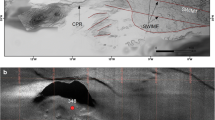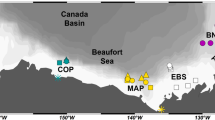Abstract
In contrast to specific large benthic invertebrates in chemosynthetic ecosystems such as hydrothermal vents, meiofaunal communities in such habitats have been reported to have strong taxonomic overlap with meiofauna in the adjacent “normal” environments. However, meiofauna have only recently been included in studies of those environments and detailed information on these communities is still rare. This is especially true in the Northwest Pacific Ocean, even though there are many seamounts with active vents in the calderas of the region. Nematode community composition at the genus level in sediments from a hydrothermal vent field in the caldera of Myojin Knoll (32°06′N, 139°52′E, depth 1,300 m), a seamount on the Izu-Ogasawara Arc, Japan, was investigated for the first time and was compared with adjacent non-vent areas inside and outside the caldera. Multivariate analyses showed that the composition of nematodes in the hydrothermal field was significantly different from that in the non-hydrothermal fields around the caldera. However, the common genera, such as Oxystomina, Pareudesmoscolex, Desmoscolex, and Microlaimus were found in two, or all three vent fields while their rank contributions differed among the three fields. When the data from Myojin Knoll were compared with those from other deep-sea vent environments in different regions (e.g., North Fiji Basin, East Pacific Rise, Mid-Atlantic Ridge), the nematode composition in the vent field of the Myojin caldera was more similar to that of the non-vent fields around the caldera than the composition in vent fields of other regions. These data from the Northwest Pacific Ocean also suggest the absence of long-range transport systems and local adaptations for meiofauna in hydrothermal vent fields.




Similar content being viewed by others
References
Akimoto K, Hattori M (2000) Recent benthic foraminiferal assemblage in the Bathymodiolus colony in the northern Iheya Ridges, Okinawa Trough, Japan. JAMSTEC J Deep Sea Res 16:49–51 (in Japanese with English abstract)
Akimoto K, Tanaka T, Hattori M, Hotta H (1990) Recent benthic assemblages from the hydrothermal deposits in the Okinawa Trough, Ryukyu Islands, Japan. JAMSTEC Deepsea Res 90:99–114 (in Japanese with English abstract)
Anderson MJ, Gorley RN, Clarke KR (2008) PERMANOVA+ for PRIMER: guide to software and statistical methods. PRIMER-E, Plymouth
Clarke KR, Warwick RM (2001) Change in marine communities: an approach to statistical analysis and interpretation, 2nd edn. PRIMER-E, Plymouth
Copley JTP, Flint HC, Ferrero TJ, Van Dover CL (2007) Diversity of meiofauna and free-living nematodes in hydrothermal vent mussel beds on the northern and southern East Pacific Rise. J Mar Biol Assoc UK 87:1141–1152
Danovaro R (2010) Methods for the study of deep-sea sediments, their functioning and biodiversity. CRC Press, New York
Dinet A, Grassle F, Tunnicliffe V (1988) Premières observations sur la méiofaune des hydrothermaux de la dorsale Est-Pacifique (Guaymas, 21°N) et de l’Explorer Ridge. Oceanol Acta 85:7–14
Flint HC, Copley JTP, Ferrero TJ, Van Dover CL (2006) Patterns of nematode diversity at hydrothermal vents on the East Pacific Rise. Cah Biol Mar 47:365–370
Fujikura K, Okutani T, Maruyama T (2008) Deep-sea life—biological observations using research submersibles. Tokai University Press, Hatano
Giere O (2009) Meiobenthology. The microscopic motile fauna of aquatic sediments, 2nd edn. Universität Hamburg, Hamburg
Gollner S, Zekely J, Govenar B, Le Bris N, Nemeschkal HL, Fisher CR, Bright M (2007) Tubeworm-associated permanent meiobenthic communities from two chemically different hydrothermal vent sites on the East Pacific Rise. Mar Ecol Prog Ser 337:39–49
Gollner S, Riemer B, Arbizu PM, Le Bris N, Bright M (2010) Diversity of meiofauna from the 9°50′N East Pacific Rise across a gradient of hydrothermal fluid emissions. PLoS ONE 5:e12321
Iizasa K, Fiske RS, Ishizuka O, Yuasa M, Hashimoto J, Ishibashi J, Naka J, Horii Y, Fujiwara Y, Imai A, Koyama S (1999) A Kuroko-type polymetallic sulfide deposit in a submarine silicic caldera. Science 283:975–977
Inoue K (2008) Cruise report Natsushima/Hyper-Dolphin NT08-07 LEG2. Japan Agency for Marine–Earth Science and Technology (JAMSTEC). http://www.godac.jamstec.go.jp/catalog/data/doc_catalog/media/NT08-07_leg2_all.pdf
Inoue K, Tsukuda K, Koito T, Miyazaki Y, Hosoi M, Kado R, Miyazaki N, Toyohara H (2008) Possible role of a taurine transporter in the deep-sea mussel Bathymodiolus septemdierum in adaptation to hydrothermal vents. FEBS Lett 582:1542–1546
Kitahashi T, Shimanaga M, Inoue K, Watanabe H (2010) Sampler bias in the quantitative study on meiofauna around hydrothermal vents: comparison of sediments collected using two types of handcorers with different diameters. JAMSTEC Rep Res Dev 10:33–39 (in Japanese with English abstract)
Kojima S (2002) Deep-sea chemoautosynthesis-based communities in the Northwestern Pacific. J Oceanogr 58:343–363
Magurran AE (1988) Ecological diversity and its measurement. Chapman and Hall, London
Masuzawa T, Handa N, Kitagawa H, Kusakabe M (1992) Sulfate reduction using methane in sediments beneath a bathyal “cold seep” giant clam community off Hatsushima Island, Sagami Bay, Japan. Earth Planet Sci Lett 110:39–50
Ogawa NO, Nagata T, Kitazato H, Ohkouchi N (2010) Ultra-sensitive elemental analyzer/isotope ratio mass spectrometer for stable nitrogen and carbon isotope analyses. In: Ohkouchi N, Tayasu I, Koba K (eds) Earth, life and isotopes. Kyoto University Press, Kyoto, pp 339–353
Shirayama Y (1992) Studies of meiofauna collected from the Iheya Ridge during the dive 541 of the “SHINKAI 2000”. Proc JAMSTEC Symp Deep Sea Res 8:287–290 (in Japanese with English abstract)
Shirayama Y, Ohta S (1990) Meiofauna in a cold-seep community off Hatsushima. J Oceanogr 46:118–124
Tayasu I, Hirasawa R, Ogawa NO, Ohkouchi N, Yamada K (2011) New organic reference materials for carbon- and nitrogen-stable isotope ratio measurements provided by the Center for Ecological Research, Kyoto University, and Institute of Biogeosciences, Japan Agency for Marine-Earth Science and Technology. Limnology 12:261–266
Van Dover CL, Fry B (1994) Microorganisms as food resources at deep-sea hydrothermal vents. Limnol Oceanogr 39:51–57
Vanreusel A, Bossche IV, Thiermann F (1997) Free-living marine nematodes from hydrothermal sediments: similarities with communities from diverse reduced habitats. Mar Ecol Prog Ser 157:207–219
Vanreusel A, De Groote A, Gollner S, Bright M (2010) Ecology and biogeography of free-living nematodes associated with chemosynthetic environments in the deep sea: a review. PLoS ONE 5:e12449
Warwick RM, Platt HN, Somerfield PJ (1998) Free-living marine nematodes, part III. Monhysterids, Field Studies Council, Shrewsbury
Watanabe H, Fujikura K, Kojima S, Miyazaki J, Fujiwara Y (2010) Japan: vent and seeps in close proximity. In: Kiel (ed) The vent and seep biota. Springer, New York, pp 379–402
Yorisue T, Inoue K, Miyake H, Kojima S (2012) Trophic structure of hydrothermal vent communities at Myojin Knoll and Nikko Seamount in the northwestern Pacific: implications for photosynthesis-derived food supply. Plankton Benthos Res 7:35–40
Zar JH (1999) Biostatistical analysis, 4th edn. Prentice-Hall, Upper Saddle River
Zekely J, Gollner S, Van Dover CL, Govenar B, Bris NL, Nemeschkal HL, Bright M (2006a) Nematode communities associated with tubeworm and mussel aggregations on the East Pacific Rise. Cah Biol Mar 47:477–482
Zekely J, Van Dover CL, Nemeschkal HL, Bright M (2006b) Hydrothermal vent meiobenthos associated with mytilid mussel aggregations from the Mid-Atlantic Ridge and the East Pacific Rise. Deep-Sea Res Ι 53:1363–1378
Zeppilli D, Danovaro R (2009) Meiofaunal diversity and assemblage structure in a shallow-water hydrothermal vent in the Pacific Ocean. Aquat Biol 5:75–84
Acknowledgments
We are grateful to the crews and staff of the RV Natsushima and the ROV Hyper-Dolphin of the Japan Agency for Marine-Earth Science and Technology (JAMSTEC). Special thanks to two anonymous reviewers, who kindly checked our manuscript.
Author information
Authors and Affiliations
Corresponding author
Additional information
Communicated by J. Grassle.
Electronic supplementary material
Below is the link to the electronic supplementary material.
Rights and permissions
About this article
Cite this article
Setoguchi, Y., Nomaki, H., Kitahashi, T. et al. Nematode community composition in hydrothermal vent and adjacent non-vent fields around Myojin Knoll, a seamount on the Izu-Ogasawara Arc in the western North Pacific Ocean. Mar Biol 161, 1775–1785 (2014). https://doi.org/10.1007/s00227-014-2460-4
Received:
Accepted:
Published:
Issue Date:
DOI: https://doi.org/10.1007/s00227-014-2460-4




